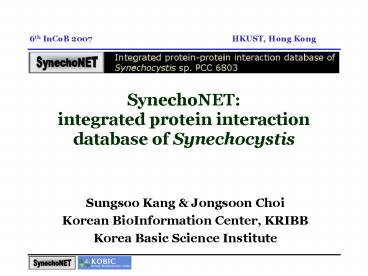SynechoNET: integrated protein interaction database of Synechocystis - PowerPoint PPT Presentation
1 / 24
Title:
SynechoNET: integrated protein interaction database of Synechocystis
Description:
a web technology that enables anyone to create and update website contents. ... Lam. T. Sll0043. Sll0038. Sll0043. Sll0039. 24. Conclusion ... – PowerPoint PPT presentation
Number of Views:119
Avg rating:3.0/5.0
Title: SynechoNET: integrated protein interaction database of Synechocystis
1
SynechoNET integrated protein interaction
database of Synechocystis
6th InCoB 2007
HKUST, Hong Kong
- Sungsoo Kang Jongsoon Choi
- Korean BioInformation Center, KRIBB
- Korea Basic Science Institute
2
Korean BioInformation Center (KOBIC)
- The national bioinformatics center of Korea
- Integration of diverse biological information
- Genome information
- Biodiversity information
- Bioresource information
- International training programs on
bioinformatics - Collaborative development of bioinformatics
tools and resources - BioWiki (online knowledge base of biology)
- BioPipe (BioWorkflow engine)
3
BioWiki
- Wiki
- a web technology that enables anyone to create
and update website contents. - suited for developing online knowledge bases
(e.g., Wikipedia ). - BioWiki
- To adopt the wiki paradigm in biology
- Collaborative development of biological
knowledge bases. - BioWiki Contest ( http//biowiki.net )
4
BioPipe
- BioWorkflow Engine
- No installation required
- Drag and drop supported
- BioPipe Contest
- Open free Web 2.0
- Period Aug 15th Sep 20th
- Website http//www.biopipe.net
- Easy way to do bioinformatics
5
SynechoNET integrated protein interaction
database of Synechocystis
6th InCoB 2007
HKUST, Hong Kong
- Sungsoo Kang Jongsoon Choi
- Korean BioInformation Center, KRIBB
- Korea Basic Science Institute
6
Cyanobacteria (Synechocystis)
- Photosynthetic bacteria with multi-layered
membranes - Photo-autotrophic or photo-heterotrophic growth
- Ancestor of plant chloroplast
7
Photosynthesis of Synechocystis
- Thylakoid membrane contains many phycobilisomes
on its surface - Phycobilisomes contain accessory pigments
absorbing light for photosynthesis
8
Synechocystis sp. PCC 6803
- Model organism of higher plants
- Plant-like oxygenic photosynthesis
- High transformation efficiency
- Light signal transduction mutants
- Undergoing systems biology pilot study
- Genome-to-Life project of DOE, USA
- The first complete genome sequence among
photosynthetic bacteria (DNA Research 1996)
Genome size 3,573,470 bp, GC content
47.7 3167 proteins (92 two-component regulatory
proteins)
9
SynechoNET
- Provides predicted protein interaction network of
Synechocystis sp. PCC 6803 - Integrates four complementary and redundant
public protein-protein interaction (PPI)
databases - Generates prediction reliability based on
redundancy - Provides predicted membrane protein information
- trans-membrane topology and domain information
10
Overview of SynechoNET System
1
2
3
4
11
Web Pages of SynechoNET
12
1. Integration of Protein Protein Interaction Data
structural interaction
interaction from multi-contexts
13
Display of predicted protein interactions and
their evidences
14
2. Prediction of Membrane Proteins
Amino acid sequence
Phobius (HMM model)
Membrane protein
Signal peptide
Profile of predicted TM topology and signal
peptide
PFAM (protein domain DB)
Predicted TM topology
Localizome (graphic module)
Transmembrane (TM) topology
Domain structure
15
Display of predicted transmembrane topology and
its evidence
16
3. External Links from SynechoNET
17
4-1. Interactive Network Analysis in SynechoNET
18
4-2. Keyword Search in SynechoNET
19
4-3. Functional Category Search in SynechoNET
20
Application of SynechoNET
- Analysis on highly interacting hub proteins in a
specific functional category - Finding upstream or downstream interacting
proteins in a cellular pathway - Functional prediction of unknown genes
- Analysis on regulatory membrane proteins
21
Interaction Network of Regulatory
Proteins(further analysis in Cytoscape program)
- No. of found genes 279
- No. of interactions 2754
22
Highly-Interacting Regulatory Proteins with a
Transmembrane Domain
23
Experimental Verification of Predicted
Interactions for Further Study
Real interaction verified by yeast two-hybrid
analysis
24
Conclusion
- SynechoNET Synechocystis-specific integrated
protein-protein interaction (PPI) database with
trans-membrane topology and domain information - Integrates PPI information from PSIMAP, iPFAM,
InterDom, and STRING - Transmembrane topology and domain information
from Phobius and Localizome - Available at http//synechocystis.org or directly
at http//bioportal.kobic.re.kr/SynechoNET/

